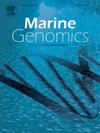降解浒苔多糖的海洋细菌Alteromonas sp. OM2203的全基因组序列
IF 1.5
4区 生物学
Q4 GENETICS & HEREDITY
引用次数: 0
摘要
绿藻藻藻(Ulva prolifera)在黄海引发了连续的绿潮,造成了有害的生态影响和经济损失。细菌对藻多糖的降解可以加速藻生物量的分解,加速藻多糖向绿潮消退阶段的过渡。本研究从青岛沿海地区藻华期间的海水样品中分离到了一株Alteromonas sp. OM2203。菌株OM2203基因组包含1条环状染色体,总长度为4556409 bp,平均GC含量为44.05%。基因组分析表明,Alteromonas sp. OM2203含有6个ulvan裂解酶基因,表明其具有降解U. prolifera多糖和加速藻类生物量分解的潜力。总的来说,Alteromonas sp. OM2203的基因组提供了Alteromonas细菌在U. prolifera多糖降解中的作用。本文章由计算机程序翻译,如有差异,请以英文原文为准。
Complete genome sequence of Alteromonas sp. OM2203, a marine bacterium degrading Ulva prolifera polysaccharides
Green algae Ulva prolifera cause successive green tides in the Yellow Sea, China, leading to harmful ecological impacts and economic losses. Bacterial degradation of U. prolifera polysaccharides could accelerate the breakdown of its biomass and transition to the waning phase of green tides. In this study, the strain Alteromonas sp. OM2203 was isolated from seawater samples in the coastal area of Qingdao during a U. prolifera bloom. The genome of strain OM2203 contains one circular chromosome totaling 4,556,409 bp, with a mean GC content of 44.05%. Genomic analysis revealed that Alteromonas sp. OM2203 contains 6 ulvan lyase genes, indicating its potential to degrade U. prolifera polysaccharides and expedite the decomposition of algal biomass. Collectively, the genome of Alteromonas sp. OM2203 provides insights into the role of Alteromonas bacteria in U. prolifera polysaccharide degradation.
求助全文
通过发布文献求助,成功后即可免费获取论文全文。
去求助
来源期刊

Marine genomics
生物-遗传学
CiteScore
3.60
自引率
5.30%
发文量
50
审稿时长
29 days
期刊介绍:
The journal publishes papers on all functional and evolutionary aspects of genes, chromatin, chromosomes and (meta)genomes of marine (and freshwater) organisms. It deals with new genome-enabled insights into the broader framework of environmental science. Topics within the scope of this journal include:
• Population genomics and ecology
• Evolutionary and developmental genomics
• Comparative genomics
• Metagenomics
• Environmental genomics
• Systems biology
More specific topics include: geographic and phylogenomic characterization of aquatic organisms, metabolic capacities and pathways of organisms and communities, biogeochemical cycles, genomics and integrative approaches applied to microbial ecology including (meta)transcriptomics and (meta)proteomics, tracking of infectious diseases, environmental stress, global climate change and ecosystem modelling.
 求助内容:
求助内容: 应助结果提醒方式:
应助结果提醒方式:


